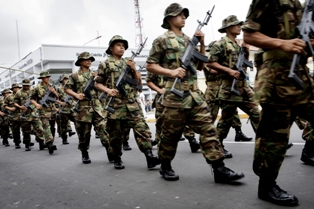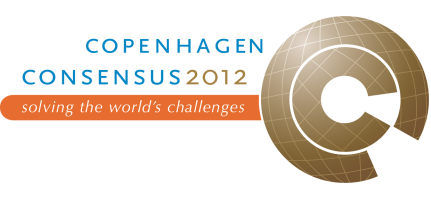Armed Conflict
The Copenhagen Consensus aims to prioritize the best solutions for the world’s most pressing issues. The third Copenhagen Consensus conference tackled the issue of Armed Conflict.
The costs from conflicts can be immense and devastating – yet they are almost always understated because we ignore the  legacies that violence leave behind. The immediately apparent, direct costs are loss of life and injury on the battlefield. But in many countries conflict leads to far greater casualties because of economic collapse so that fewer can afford health care, proper food and education. Because of the long lag in economic recovery after a conflict, people will die for years after a conflict ends.
legacies that violence leave behind. The immediately apparent, direct costs are loss of life and injury on the battlefield. But in many countries conflict leads to far greater casualties because of economic collapse so that fewer can afford health care, proper food and education. Because of the long lag in economic recovery after a conflict, people will die for years after a conflict ends.
J. Paul Dunne conducted research on the topic for Copenhagen Consensus and found three cost-effective solutions to conflict: prevention, intervention, and post-conflict reconstruction.
Prevention
According to Dunne, conflict prevention is the most cost-effective solution. The causes of conflict are hugely varied and the roots of war are multifaceted, with important historical contexts. So how can we stop conflicts before they occur?
Dunne pinpoints early warning mechanisms, peacekeeping operations, economic sanctions and aid as the tools that have proven effective in preventing conflicts.
Dunne calculates that spending about US$56 billion over four years on a combination of these measures would lead to benefits to the magnitude of at least US$606 billion. Among these benefits, the avoided deaths, injuries, and other conflict-related violence are perhaps the most compelling arguments for the use of available funds for prevention.
Given the high possible benefits and low costs of prevention efforts, conflict prevention has a benefit cost ratio of at least 11. This means that, when we look at it entirely in economic terms, each dollar spent achieves benefits worth at least $11 dollars, making it an impressively beneficial solution.
Intervention
If conflicts do break out, the next stage is possible intervention. At this stage it will be impossible to avoid a significant part of the cost of conflict and it the intervention itself will also be more costly. The projected cost of intervention of about US$100 billion includes better intelligence, economic sanctions and aid as well as most likely military intervention. This is nearly double the cost of preventing a conflict in the first place.
Yet, with benefits of at least $606 billion, there are still large pay-offs to be reaped. For each dollar spent, we can avoid conflict damage worth about $5, making intervention a cost-effective use of resources.
Reconstruction
The need for reconstruction is, of course, contingent on the nature of the conflict and the way that it ended. Most of the costs of conflict have already been incurred, but still there is a benefit to be reaped by making post-recovery faster and the risk of relapse smaller.
 Post-conflict policies can be costly but are also cost-effective in preventing suffering and building up economies that provide new markets and raw materials. According to research by former Copenhagen Consensus expert panel member and researcher Paul Collier, economic reconstruction reduces the risk of a renewed outbreak of conflict by 42% in ten years.
Post-conflict policies can be costly but are also cost-effective in preventing suffering and building up economies that provide new markets and raw materials. According to research by former Copenhagen Consensus expert panel member and researcher Paul Collier, economic reconstruction reduces the risk of a renewed outbreak of conflict by 42% in ten years.
The cost of post-conflict policies is higher than intervention at around $140bn, and the benefits are also smaller at $404bn. In total, it is estimated that each dollar will avoid at least $3 of conflict damage. While post-conflict policies may not have the highest benefit-cost ratio, Dunne argues that they are crucial in ensuring successful development can occur.
For that reason, these policies are already attracting considerable resources from the international donor community.
In Summary
Dunne emphasizes that although he has examined many of the different ways that conflicts impose a cost on society, the true cost is still likely to be hugely underestimated. There are immeasurable quantities and legacy costs that are difficult to identify. The existence of drugs, criminal gangs and violence in South American countries such as Colombia in the present day, for example, can be traced back to the ending of an armed conflict without true peace being achieved.
The bottom line is that without peace there cannot be development and solving other challenges becomes impossible.


